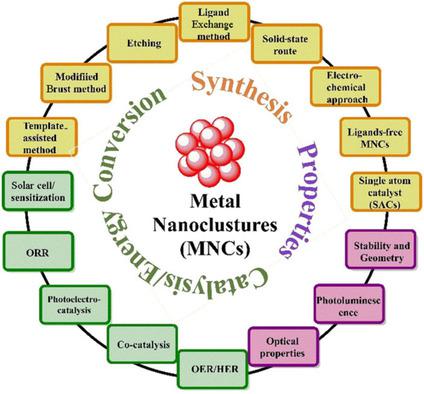当前位置:
X-MOL 学术
›
ChemSusChem
›
论文详情
Our official English website, www.x-mol.net, welcomes your
feedback! (Note: you will need to create a separate account there.)
Metal Nanoclusters: New Paradigm in Catalysis for Water Splitting, Solar and Chemical Energy Conversion
ChemSusChem ( IF 7.5 ) Pub Date : 2019-03-28 , DOI: 10.1002/cssc.201802069 Akhtar Munir 1 , Khurram Saleem Joya 2, 3 , Tanveer Ul haq 1 , Noor‐Ul‐Ain Babar 2 , Syed Zajif Hussain 1 , Ahsanulhaq Qurashi 4 , Najeeb Ullah 5 , Irshad Hussain 1
ChemSusChem ( IF 7.5 ) Pub Date : 2019-03-28 , DOI: 10.1002/cssc.201802069 Akhtar Munir 1 , Khurram Saleem Joya 2, 3 , Tanveer Ul haq 1 , Noor‐Ul‐Ain Babar 2 , Syed Zajif Hussain 1 , Ahsanulhaq Qurashi 4 , Najeeb Ullah 5 , Irshad Hussain 1
Affiliation

|
A sustainable future demands innovative breakthroughs in science and technology today, especially in the energy sector. Earth‐abundant resources can be explored and used to develop renewable and sustainable resources of energy to meet the ever‐increasing global energy demand. Efficient solar‐powered conversion systems exploiting inexpensive and robust catalytic materials for the photo‐ and photo‐electro‐catalytic water splitting, photovoltaic cells, fuel cells, and usage of waste products (such as CO2) as chemical fuels are appealing solutions. Many electrocatalysts and nanomaterials have been extensively studied in this regard. Low overpotentials, catalytic stability, and accessibility remain major challenges. Metal nanoclusters (NCs, ≤3 nm) with dimensions between molecule and nanoparticles (NPs) are innovative materials in catalysis. They behave like a “superatom” with exciting size‐ and facet‐dependent properties and dynamic intrinsic characteristics. Being an emerging field in recent scientific endeavors, metal NCs are believed to replace the natural photosystem II for the generation of green electrons in a viable way to facilitate the challenging catalytic processes in energy‐conversion schemes. This Review aims to discuss metal NCs in terms of their unique physicochemical properties, possible synthetic approaches by wet chemistry, and various applications (mostly recent advances in the electrochemical and photo‐electrochemical water splitting cycle and the oxygen reduction reaction in fuel cells). Moreover, the significant role that MNCs play in dye‐sensitized solar cells and nanoarrays as a light‐harvesting antenna, the electrochemical reduction of CO2 into fuels, and concluding remarks about the present and future perspectives of MNCs in the frontiers of surface science are also critically reviewed.
中文翻译:

金属纳米团簇:用于水分解,太阳能和化学能转化的催化新范式
可持续的未来需要当今科学技术的创新突破,尤其是在能源领域。可以探索地球上丰富的资源,并将其用于开发可再生和可持续的能源资源,以满足不断增长的全球能源需求。高效的太阳能转换系统,利用廉价而坚固的催化材料进行光催化和光催化水分解,光伏电池,燃料电池以及废品(例如CO 2)的使用),因为化学燃料是吸引人的解决方案。在这方面已经对许多电催化剂和纳米材料进行了广泛的研究。低过电位,催化稳定性和可及性仍然是主要挑战。金属纳米团簇(NCs,≤3nm),尺寸介于分子和纳米颗粒(NPs)之间,是催化领域的创新材料。它们的行为就像一个“超级原子”,具有令人兴奋的大小和构面相关的特性以及动态的固有特性。作为近代科学工作中的新兴领域,据信金属NC替代了天然光系统II,从而以可行的方式促进绿色电子的产生,以促进能量转换方案中具有挑战性的催化过程。本文旨在就金属NC的独特理化性质,通过湿化学的可能合成方法,和各种应用(最近在电化学和光电化学水分解循环以及燃料电池中的氧还原反应方面取得了最新进展)。此外,跨国公司在染料敏化太阳能电池和纳米阵列中作为集光天线发挥着重要作用,CO的电化学还原2成为燃料,并严格审查了跨国公司在表面科学领域的当前和未来观点的总结性发言。
更新日期:2019-03-28
中文翻译:

金属纳米团簇:用于水分解,太阳能和化学能转化的催化新范式
可持续的未来需要当今科学技术的创新突破,尤其是在能源领域。可以探索地球上丰富的资源,并将其用于开发可再生和可持续的能源资源,以满足不断增长的全球能源需求。高效的太阳能转换系统,利用廉价而坚固的催化材料进行光催化和光催化水分解,光伏电池,燃料电池以及废品(例如CO 2)的使用),因为化学燃料是吸引人的解决方案。在这方面已经对许多电催化剂和纳米材料进行了广泛的研究。低过电位,催化稳定性和可及性仍然是主要挑战。金属纳米团簇(NCs,≤3nm),尺寸介于分子和纳米颗粒(NPs)之间,是催化领域的创新材料。它们的行为就像一个“超级原子”,具有令人兴奋的大小和构面相关的特性以及动态的固有特性。作为近代科学工作中的新兴领域,据信金属NC替代了天然光系统II,从而以可行的方式促进绿色电子的产生,以促进能量转换方案中具有挑战性的催化过程。本文旨在就金属NC的独特理化性质,通过湿化学的可能合成方法,和各种应用(最近在电化学和光电化学水分解循环以及燃料电池中的氧还原反应方面取得了最新进展)。此外,跨国公司在染料敏化太阳能电池和纳米阵列中作为集光天线发挥着重要作用,CO的电化学还原2成为燃料,并严格审查了跨国公司在表面科学领域的当前和未来观点的总结性发言。











































 京公网安备 11010802027423号
京公网安备 11010802027423号